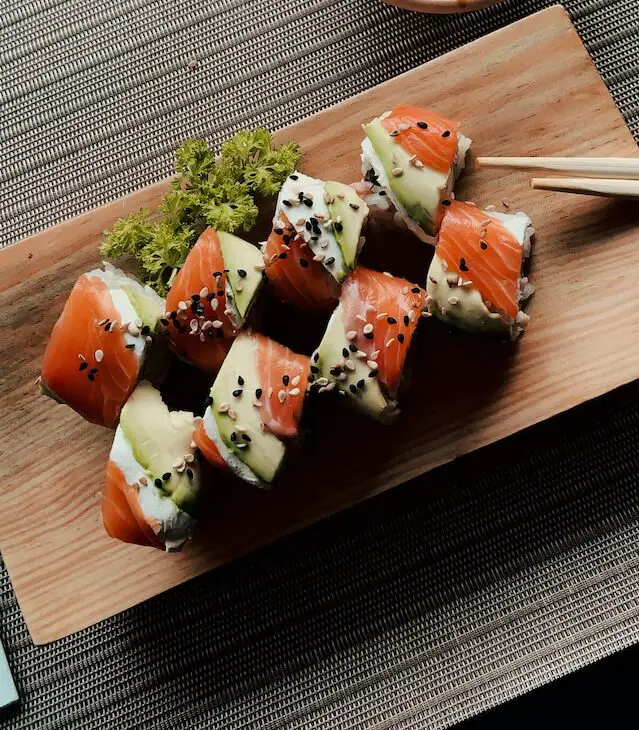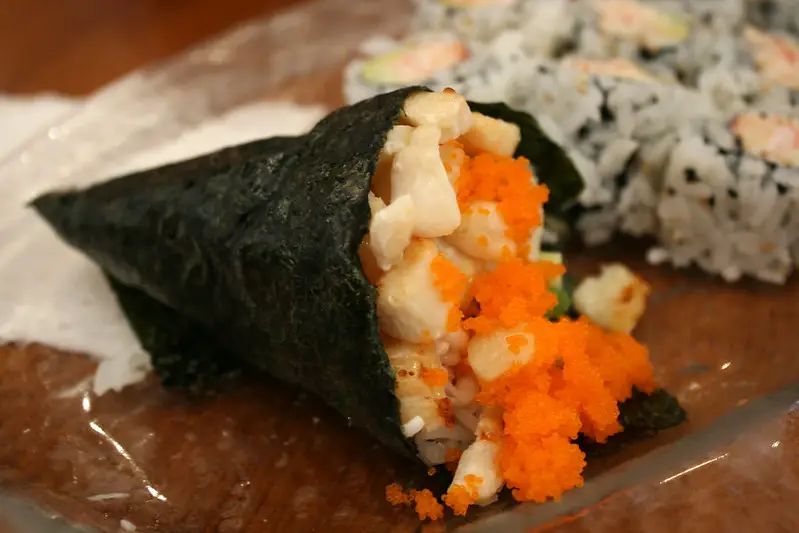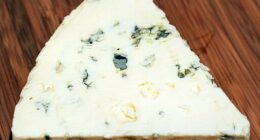Cut roll sushi is made by rolling sushi rice and various fillings inside a sheet of nori seaweed, then cutting the roll into bite-sized pieces. Hand roll sushi, on the other hand, is made by wrapping sushi rice and fillings in a cone-shaped piece of nori seaweed that is meant to be eaten with the hands.
What is sushi?
Sushi is a popular Japanese dish that has become an international favorite. This delicacy consists of bite-sized pieces of vinegared rice or sushi rice, topped with different ingredients such as raw fish, vegetables, and egg. The word “sushi” originally referred to the sour taste of the fermented rice used in old-style sushi making.
Today’s sushi-making involves a combination of fresh ingredients like seafood, vegetables, fruits and sauces rolled up into seaweed sheets called nori or wrapped in a cone-shaped hand roll made from dried seaweed.
The origin story behind Sushi dates back over 2000 years ago when it was first introduced in Southeast Asia as a way to preserve fish for longer periods by fermenting it with vinegar-soaked rice. Over time, this preservation method evolved into what we call modern-day sushi today.
Sushi comes in many forms including cut rolls (maki), hand rolls (temaki), nigiri (small oval-shaped balls) and sashimi which does not contain any rice at all.
What is cut roll sushi?
(Photo by Derek Duran on Unsplash )

Cut roll sushi, also known as maki sushi or rolled sushi, is a traditional Japanese dish composed of rice and various fillings wrapped in seaweed sheets. The filling can vary from raw fish to vegetables to cooked meats. Cut roll sushi gets its name because it is typically prepared by taking a sheet of nori (dried seaweed) and spreading seasoned sushi rice over the top before adding in the desired ingredients.
Once all of the ingredients are layered on top, the chef carefully rolls everything together tightly using a bamboo mat. This creates a long tube-like shape that is then sliced into smaller pieces for serving. Cut roll sushi comes in different sizes depending on how many pieces it was cut into.
Some popular types of cut roll sushi include California Rolls, Spicy Tuna Rolls, and Salmon Avocado Rolls. They are often served with soy sauce and wasabi paste for dipping.
Cut roll sushi has become increasingly popular worldwide due to its delicious taste and healthy ingredients. It’s no wonder why this classic Japanese cuisine remains one of the most beloved dishes around!
What is hand roll sushi?
(Photo By Quinn Dombrowski on Flickr)

Hand roll sushi, also known as “temaki,” is a type of sushi that is made by hand. It is traditionally shaped like an ice cream cone and can be filled with various ingredients such as fish, vegetables, rice, and seaweed.
One unique aspect of hand roll sushi is the texture. Unlike cut roll sushi, where the ingredients are tightly packed together in a tube shape and sliced into smaller pieces, hand rolls have a looser filling that allows for more distinct flavors to come through with each bite.
Another unique feature of hand roll sushi is its portability. Due to its shape and size, it’s easy to eat on-the-go or enjoy as a quick snack.
Making your own hand rolls at home can be fun and simple. Begin by laying out a sheet of nori (seaweed) on a flat surface. Add some cooked rice onto one end of the sheet and then fill it with your favorite ingredients before rolling it up into an ice cream cone shape.
Hand roll sushi offers a fresh take on traditional Japanese cuisine that’s perfect for those who love bold flavors and convenience all rolled into one delicious treat!
Cut roll sushi Vs. Hand roll sushi – Key differences
Cut roll sushi and hand roll sushi are two popular types of sushi that differ in their shape, size, and texture. Cut roll sushi is the more familiar type often seen on menus at Japanese restaurants worldwide. It is made by rolling a layer of rice with seaweed around an assortment of ingredients (seafood or vegetables) tightly then sliced into bite-sized pieces.
Hand roll sushi, as its name suggests, is shaped like a cone and typically filled with one type of filling only to be eaten immediately after being rolled up by hand. The filling options for hand rolls are usually limited to one or two ingredients per cone.
The taste difference between cut rolls vs. hand rolls lies within the interplay between all of its components where cut rolls tend to highlight the flavors separately while hand rolls result in greater complexity with every bite. Additionally, each type has a distinct texture – cut rolls have denser consistency while hand-rolls offer different textures depending on how they’re wrapped together.
It comes down to personal preference – whether you prefer convenience or want to enjoy a unique experience when eating Sushi – both methods provide delicious taste experiences so it’s worth trying them both!
How to make your own sushi?
Making your own sushi can be a fun and rewarding experience. However, it can also be intimidating if you’re not familiar with the process. Here’s a step-by-step guide to making your own cut roll or hand roll sushi at home.
First, gather all the necessary ingredients – sushi rice, nori sheets, fillings of your choice (like avocado, cucumber, crab meat), soy sauce and wasabi.
Next, cook the sushi rice according to package instructions. Once done, mix in some rice vinegar and sugar for flavor.
For cut roll sushi: Place a sheet of nori on top of a bamboo mat or plastic wrap and spread an even layer of cooked rice over it leaving one inch empty from top edge. Add your desired fillings on top of the rice layer then carefully start rolling using mat as support while ensuring its tightness along each turn until it reaches end part without sealing yet; dab water on that last inch edge before finishing off rolling tightly then slice into pieces.
For hand roll sushi: Take another sheet of nori and fold it in half diagonally to create a triangle shape. Then add cooked rice onto one side of the triangle followed by preferred fillings close enough to form cone-like shape then seal edges together tightly forming handlebar mustache looking shaped rolls.
Finally serve with soy sauce mixed with wasabi paste for dipping or sprinkle sesame seeds on top for added crunchiness!
Why is sushi so expensive?
Sushi is widely known for being a pricey delicacy, but have you ever wondered why? One reason is the quality of ingredients used. Fresh and high-quality fish can cost a pretty penny, especially if it needs to be imported. Sushi chefs also require specialized training and experience to ensure each roll is perfectly crafted with precision and care.
Another factor that contributes to the cost of sushi is the time-consuming process involved in preparing it. Each piece of sushi requires careful attention and meticulous planning from start to finish. From cooking the rice just right to slicing the fish into perfect bite-size pieces, every step takes time and effort.
The ambiance of a sushi restaurant also plays a role in its pricing. Many upscale establishments invest heavily in décor, lighting, music, and overall atmosphere which ultimately reflects on their prices.
Let’s not forget about supply and demand. The popularity of sushi has only grown over recent years resulting in an increase in demand leading restaurants to raise their prices accordingly.
Several factors contribute towards making sushi an expensive treat for many people worldwide. Nonetheless, those who appreciate this delicious cuisine know that it’s worth splurging on once in a while!
Featured Image By – Mahmoud Fawzy on Unsplash








